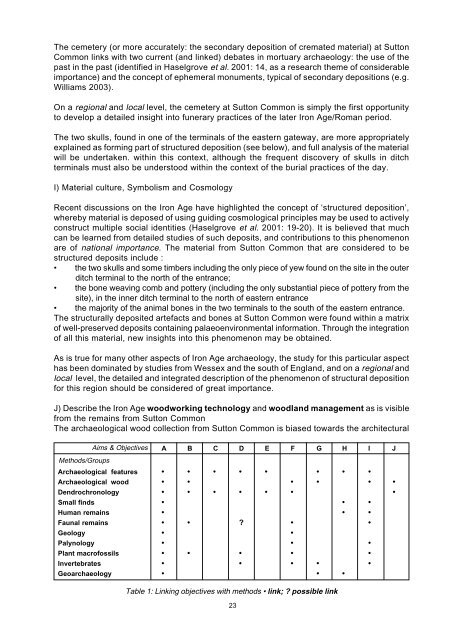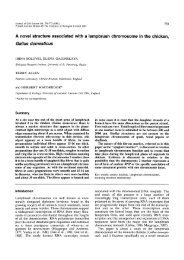Sutton Common Updated project design - University of Exeter
Sutton Common Updated project design - University of Exeter
Sutton Common Updated project design - University of Exeter
Create successful ePaper yourself
Turn your PDF publications into a flip-book with our unique Google optimized e-Paper software.
The cemetery (or more accurately: the secondary deposition <strong>of</strong> cremated material) at <strong>Sutton</strong><br />
<strong>Common</strong> links with two current (and linked) debates in mortuary archaeology: the use <strong>of</strong> the<br />
past in the past (identified in Haselgrove et al. 2001: 14, as a research theme <strong>of</strong> considerable<br />
importance) and the concept <strong>of</strong> ephemeral monuments, typical <strong>of</strong> secondary depositions (e.g.<br />
Williams 2003).<br />
On a regional and local level, the cemetery at <strong>Sutton</strong> <strong>Common</strong> is simply the first opportunity<br />
to develop a detailed insight into funerary practices <strong>of</strong> the later Iron Age/Roman period.<br />
The two skulls, found in one <strong>of</strong> the terminals <strong>of</strong> the eastern gateway, are more appropriately<br />
explained as forming part <strong>of</strong> structured deposition (see below), and full analysis <strong>of</strong> the material<br />
will be undertaken. within this context, although the frequent discovery <strong>of</strong> skulls in ditch<br />
terminals must also be understood within the context <strong>of</strong> the burial practices <strong>of</strong> the day.<br />
I) Material culture, Symbolism and Cosmology<br />
Recent discussions on the Iron Age have highlighted the concept <strong>of</strong> ‘structured deposition’,<br />
whereby material is deposed <strong>of</strong> using guiding cosmological principles may be used to actively<br />
construct multiple social identities (Haselgrove et al. 2001: 19-20). It is believed that much<br />
can be learned from detailed studies <strong>of</strong> such deposits, and contributions to this phenomenon<br />
are <strong>of</strong> national importance. The material from <strong>Sutton</strong> <strong>Common</strong> that are considered to be<br />
structured deposits include :<br />
• the two skulls and some timbers including the only piece <strong>of</strong> yew found on the site in the outer<br />
ditch terminal to the north <strong>of</strong> the entrance;<br />
• the bone weaving comb and pottery (including the only substantial piece <strong>of</strong> pottery from the<br />
site), in the inner ditch terminal to the north <strong>of</strong> eastern entrance<br />
• the majority <strong>of</strong> the animal bones in the two terminals to the south <strong>of</strong> the eastern entrance.<br />
The structurally deposited artefacts and bones at <strong>Sutton</strong> <strong>Common</strong> were found within a matrix<br />
<strong>of</strong> well-preserved deposits containing palaeoenvironmental information. Through the integration<br />
<strong>of</strong> all this material, new insights into this phenomenon may be obtained.<br />
As is true for many other aspects <strong>of</strong> Iron Age archaeology, the study for this particular aspect<br />
has been dominated by studies from Wessex and the south <strong>of</strong> England, and on a regional and<br />
local level, the detailed and integrated description <strong>of</strong> the phenomenon <strong>of</strong> structural deposition<br />
for this region should be considered <strong>of</strong> great importance.<br />
J) Describe the Iron Age woodworking technology and woodland management as is visible<br />
from the remains from <strong>Sutton</strong> <strong>Common</strong><br />
The archaeological wood collection from <strong>Sutton</strong> <strong>Common</strong> is biased towards the architectural<br />
Aims & Objectives<br />
Methods/Groups<br />
A B C D E F G H I J<br />
Archaeological features • • • • • • • •<br />
Archaeological wood • • • • • •<br />
Dendrochronology • • • • • • •<br />
Small finds • • •<br />
Human remains • • •<br />
Faunal remains • • • •<br />
Geology • •<br />
Palynology • • •<br />
Plant macr<strong>of</strong>ossils • • • • •<br />
Invertebrates • • • • •<br />
Geoarchaeology • • •<br />
Table 1: Linking objectives with methods • link; possible link<br />
23
















